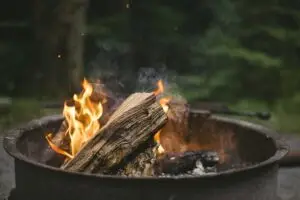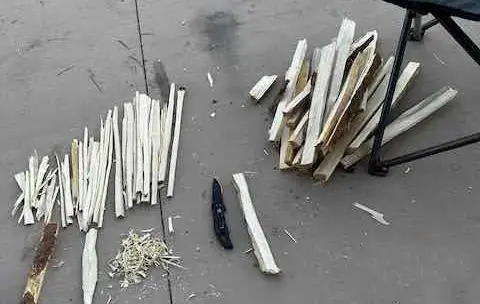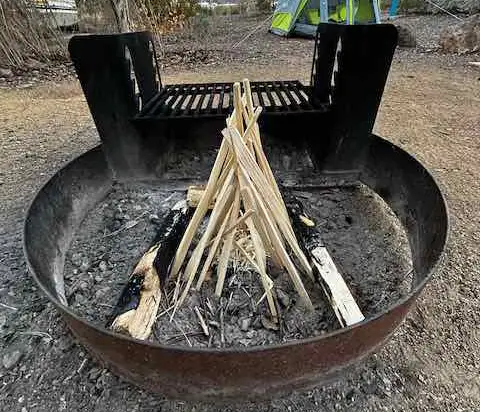Starting a campfire might seem a bit intimidating—especially when you factor in safety concerns—but the good news is, it’s not as hard as it looks! With a little practice, some basic know-how, and a focus on safety, you’ll be gathering around your very own campfire in no time.
In this blog, I’ll walk you through everything you need to know to build a campfire safely, step by step. Whether you’re roasting marshmallows, telling stories, or just taking in the peace and quiet of nature, building a safe campfire is an essential camping skill that every camper should learn.
Why Is Campfire Safety So Important?
Before we dive into the steps of building a campfire, it’s important to understand why safety matters so much.
Campfires can quickly get out of hand if they’re not built or managed properly, potentially leading to wildfires or injuries. In fact, according to the National Park Service, almost 85% of wildfires are caused by human activities, and improperly managed campfires are a big part of that statistic.
But don’t worry—by following a few simple guidelines, you’ll be able to enjoy your campfire safely without any problems. It’s all about being prepared, staying aware, and respecting nature.
Step 1: Choose the Right Location for Your Campfire
One of the first things to think about when building a campfire is where you’re going to place it. Choosing the right location is key to keeping your fire under control and ensuring everyone’s safety.
Use Designated Fire Pits
The best and safest place to start your campfire is in a designated fire pit. Most established campgrounds provide fire rings or metal fire pits specifically designed for safe campfires. These areas are cleared of any flammable material and are often positioned away from trees, bushes, and tents.

If There’s No Fire Pit Available
If you’re camping in a more primitive area without a designated fire pit, you’ll need to create your own fire ring. Here’s how to do it safely:
1. Find a flat, open spot: Look for a spot at least 15 feet away from tents, trees, shrubs, and other flammable objects.
2. Clear the area: Remove any leaves, sticks, or debris that could catch fire. You’ll want a bare patch of dirt where you can build your fire.
3. Surround the fire area with rocks: Build a circle of rocks around your fire spot. This creates a barrier that helps contain the fire and prevents it from spreading.
Step 2: Gather the Right Materials
To build a successful campfire, you’ll need three basic types of materials: tinder, kindling, and fuel. Each serves a specific purpose in helping your fire start and grow.
1. Tinder
Tinder is the small, dry material that catches fire quickly. Think of it as the “spark” that gets your fire going. Some great examples of tinder include:
- Dry leaves or grass
- Pine needles
- Birch bark
- Cotton balls (if you’re packing your own)
- Dryer lint (yep, this works great!)
Make sure your tinder is bone dry. Even slightly damp tinder can make starting a fire difficult.
2. Kindling
Kindling is slightly larger than tinder and helps build the flame once your tinder is burning. Think small sticks or twigs that are about the size of a pencil. Like tinder, kindling needs to be dry in order to catch fire easily.
3. Fuel (Firewood)
The final ingredient for a good campfire is fuel, which is what keeps the fire going once it’s started. Fuel consists of larger logs or pieces of wood. You’ll want a mix of small, medium, and large logs, so your fire has enough material to burn through.
Most campgrounds sell firewood, which is the safest and easiest option. If you’re gathering wood on your own, stick to dead and fallen wood. Never cut branches or trees in a forested area—that can disrupt the ecosystem, and in some areas, it’s illegal.

Step 3: Build Your Fire
Now that you’ve got your materials, it’s time to build your fire! There are several methods you can use to build a campfire, but for beginners, we’ll go over two of the easiest and most effective: the teepee method and the log cabin method.
The Teepee Method
The teepee method is one of the most common ways to build a campfire because it’s simple and effective.

1. Place your tinder in the center of your fire pit or ring.
2. Arrange small sticks of kindling in a teepee shape over the tinder, leaving enough space for airflow. The goal is to create a small structure that allows oxygen to flow through while your fire gets going.
3. Light the tinder, either with a match or a lighter. The flames should catch the kindling quickly.
4. Add larger pieces of wood once the fire is burning steadily. Continue to arrange them in a teepee shape as the fire grows.
The teepee method works well because it allows the fire to build from the inside out, providing a good balance of heat and oxygen.
The Log Cabin Method

The log cabin method is another easy way to build a fire that burns evenly and steadily.
1. Place your tinder in the center of the fire pit.
2. Build a square structure around the tinder by stacking two pieces of kindling parallel to each other, then two more pieces on top, perpendicular to the first two (creating a square shape). Repeat until you have a small “log cabin.”
3. Light the tinder in the middle, and the fire will grow as the kindling catches flame.
4. Add larger logs as the fire strengthens.
This method creates a sturdy fire with good airflow, making it ideal for beginners.
Step 4: Light Your Fire Safely
Lighting your fire is the moment of truth! When you’re ready to light your fire, follow these steps to ensure safety:
1. Use a long-reach lighter or matches to light your tinder. These tools keep your hands a safe distance away from the flames.
2. Light the tinder from multiple sides to ensure the fire spreads evenly (optional).
3. Avoid using lighter fluid or other accelerants. While it might seem like an easy way to start a fire, using flammable liquids can be extremely dangerous and unpredictable. Stick with natural materials like dry tinder and kindling.
Step 5: Maintain Your Campfire
Once your campfire is burning, you’ll need to keep it under control and ensure it stays safe throughout the night.
Keep Your Fire Small
There’s no need to build a towering bonfire—small, manageable fires are safer and easier to control. Plus, they’re better for roasting marshmallows!
Never Leave Your Fire Unattended
It’s important to always keep an eye on your campfire. If you need to step away (even for a short time), make sure to ask someone else to watch it or extinguish it before leaving. Fires can spread quickly, so keeping a close watch is crucial for safety.
Keep Water Nearby
Always have a bucket of water or a shovel on hand in case you need to quickly extinguish the fire. If things get out of control, you’ll want to act fast to prevent any accidents.
Step 6: Extinguish Your Fire Properly
When you’re ready to call it a night or leave the campsite, make sure to put out your fire completely. Here’s how:
1. Pour water over the fire until all the embers stop burning. Be thorough—don’t just pour water on the flames; make sure the fire is completely out.
2. Stir the ashes with a stick or shovel to make sure every ember is soaked. Even a small, smoldering ember can reignite if it’s left unattended.
3. Check the area around your fire pit to ensure that no stray embers or sparks have spread.
Never leave a campfire burning overnight or when you leave the campsite—it’s a serious fire hazard.
Bonus Tip: Check Local Fire Regulations
Before you head out on your camping trip, it’s important to check local fire regulations. Some areas may have fire bans during dry seasons to prevent wildfires. Make sure to follow any rules or restrictions to keep yourself, others, and the environment safe.
Conclusion: A Safe Campfire Is a Happy Campfire
Building a campfire is one of the most enjoyable parts of camping, and with a little preparation and attention to safety, it can be easy and fun. Whether you’re using the teepee or log cabin method, remember to always follow the basics: choose the right location, gather the right materials, keep it small, and never leave it unattended. By respecting fire safety rules, you’ll not only protect yourself and the environment but also make lasting memories around the warmth of a crackling fire.
So grab your marshmallows, sit back, and enjoy the magic of your first campfire—you’ve earned it!
Explore more. Fear less.
- Why Road Trips are One of the Best Ways to Clear Your Mind - November 21, 2024
- 10 of the Best Pumpkin Patches in the U.S. - October 23, 2024
- 10 of the Most Colorful Fall Road Trips in the U.S. - October 22, 2024
